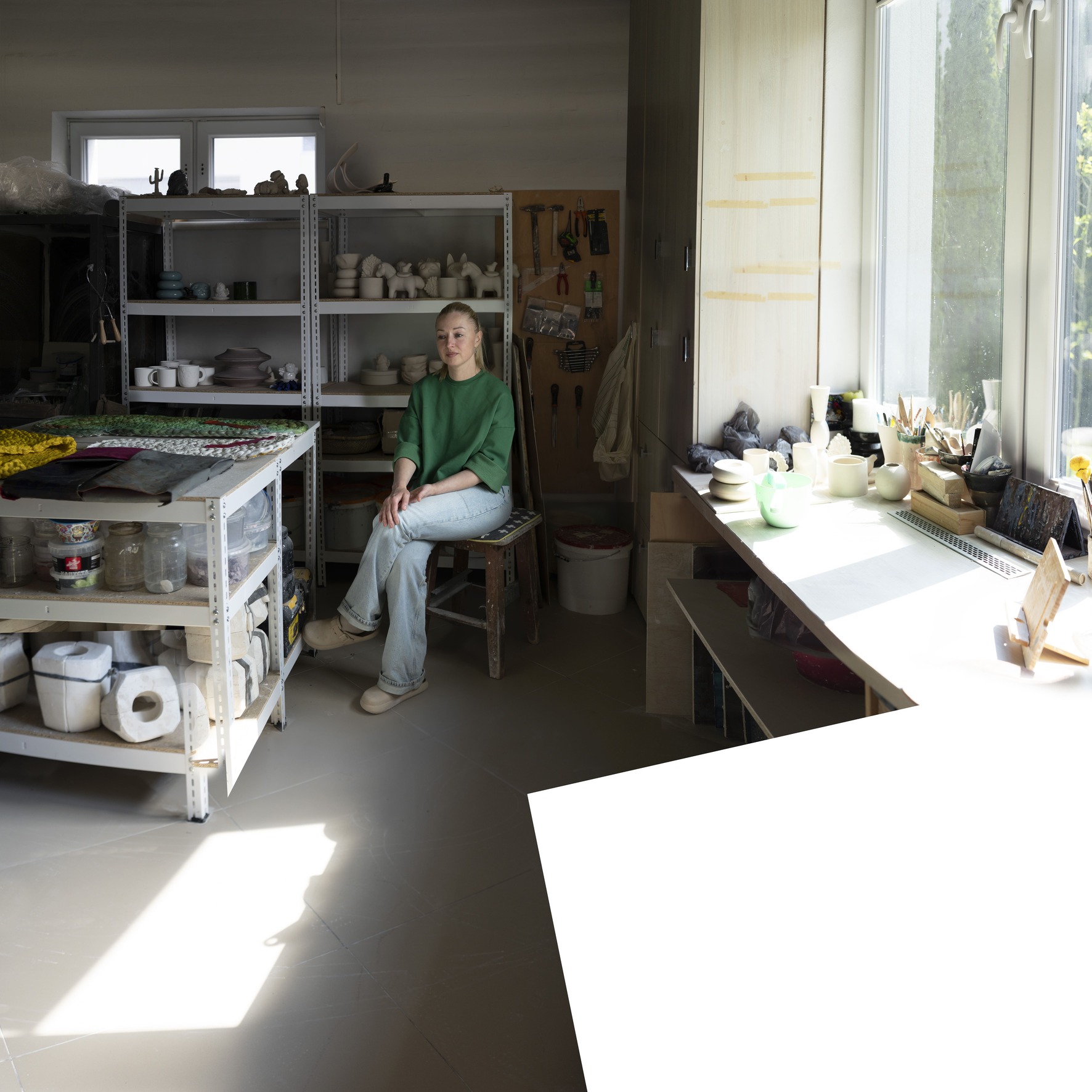Ольга Пильник
Olha Pylnyk
«Як не парадоксально, саме відчуття небезпеки й усвідомлення, що смерть стала ближчою, зробили стосунки з дітьми та чоловіком глибшими, щирішими».

З серії «Before the Future», 2025
Друк на Hahnemuhle Photo Rag Metallic, Dibond
Художниця евакуювалася з дітьми за кордон у березні 2022 року, провела сім місяців в Австрії, а згодом повернулася додому, в реальність блекаутів, сирен і постійної напруги. Під сходами свого будинку вона облаштувала укриття, куди вони з дітьми та чоловіком ховаються під час повітряних тривог.
Як не парадоксально, саме відчуття небезпеки й усвідомлення, що смерть стала ближчою, зробили стосунки з дітьми та чоловіком глибшими, щирішими.
Перебування в Австрії дало тимчасову підтримку, можливість повернутися до глини, шамоту – звичної мистецької практики. Проте реалії випалу кераміки та складнощі з доступом до студій зумовили пошук інших форм – так з’явилися перші експерименти з текстилем. Пошарпані простирадла з секонд-хенду, які вона рвала, сплітала, зшивала – стали метафорою і власного стану, і крихкої реальності. Цей перехід до нових матеріалів супроводжувався і внутрішніми змінами: почуттям вразливості, водночас посиленим відчуттям відповідальності та готовністю брати на себе більше.
Після повернення Ольга опинилася в періоді переоцінки. Колись свобода творчості здавалася природною, тепер вона відсутня. Внутрішній стан не дозволяє зараз творити у звичному сенсі. Для мистецтва потрібен ментальний ресурс, здатність довго обмірковувати, перебувати в ідеї. А в умовах постійної тривожності, необхідності дбати про дітей і нестабільної економічної ситуації – на це не вистачає сил.
Натомість з’явилась потреба у фінансовій опорі для сім’ї. Через складну ситуацію з роботою чоловіка, Ольга зосередилася на серійному виробництві, комерційних замовленнях, продажах через Instagram і галереї.
Мистецтво більше не виняткове місце натхнення. Це робота, яка дисциплінує і заземляє. Перерва у мистецьких проєктах та фокус на комерційній діяльності – це свідоме рішення не тиснути на себе за відсутності внутрішнього ресурсу.
Немає бажання створювати великі висловлювання про війну, увійти в історію мистецтва. Завдання в тому, щоб не зупинитися. У тому, щоб кожного дня працювати, підтримувати, дбати. Її позиція – це дія. І головний меседж: «Життя в Україні не зупинилося. Ми живемо. Ми боремося. Кожен на своєму місці».
Її досвід – це також досвід жіночої відповідальності під час війни. Багато чоловіків воюють, жінки беруть на себе все інше: виховання дітей, логістику, заробітки, комунікацію зі світом. Зараз жінки беруть на себе й те, що раніше сприймалося як «чоловіче». У цьому не тільки необхідність, а й сила.
‘Paradoxically, it was the sense of danger — the awareness that death was near — that deepened my relationships with my children and husband, made them more sincere, more alive.’
In March 2022, Olha Pylnyk evacuated abroad with her children. They spent seven months in Austria before returning home — to a reality of blackouts, sirens, and constant tension. Under the staircase of their building, she built a makeshift shelter, where she, her husband, and their children now hide during air raids.
Paradoxically, it was precisely the proximity of danger — the awareness that death was no longer abstraсt — that brought greater emotional depth and honesty to her family relationships.
Austria offered temporary support and a chance to return to her familiar practice — working with clay and chamotte. But the realities of ceramic firing and limited access to studios pushed her to explore new forms. She began experimenting with textiles — ripping, weaving, and stitching worn sheets from second-hand shops. These materials became a metaphor for her own emotional state — and for the fragility of life itself.
This shift in materials coincided with an inner transformation: a growing sense of vulnerability, accompanied by a heightened responsibility and a readiness to carry more.
Upon returning, Olha entered a period of reevaluation. Creative freedom, once taken for granted, now felt distant. Her mental state no longer allowed her to create as she once had. Art requires emotional bandwidth, time for ideas to gestate. But in a reality defined by constant anxiety, caring for children, and financial instability, there simply wasn’t enough space.
Instead, a different need arose: to be the financial backbone of the family. With her husband’s work severely affected by the war, Olha turned toward serial production — fulfilling commercial orders andselling through Instagram and galleries.
Art was no longer a sacred space of inspiration — it became work. Grounding, routine, discipline. The pause in artistic projects and the focus on commercial output was a conscious decision — to stop pressuring herself for not having inner reserves.
There’s no desire to make grand statements about the war, no ambition to carve a place in art history. The task is more modest — and more enduring: to keep going. To work every day. To support, to care. Her position is clear: action. And the message is simple yet vital: Life in Ukraine has not stopped. We live. We fight. Each of us — in our own way.
Her experience is also a testament to the weight of female responsibility during wartime. As men go to the front, women take on everything else: raising children, managing households, earning income, and maintaining connections with the outside world. Now they carry even what used to be considered ‘men’s work’. Not just out of necessity — but from strength.